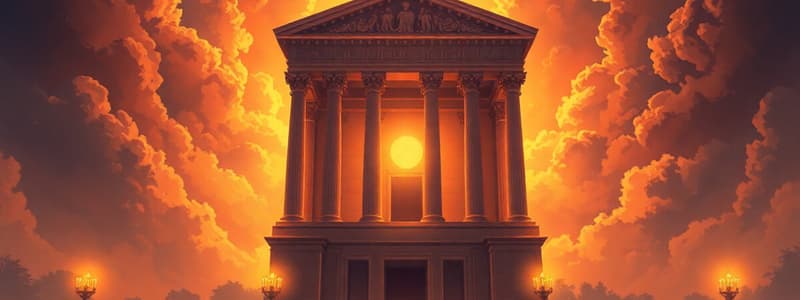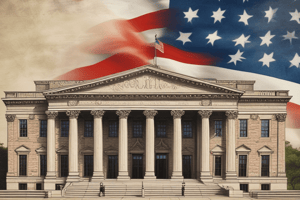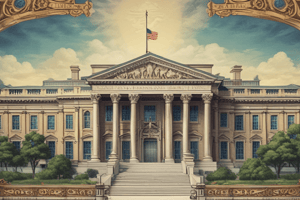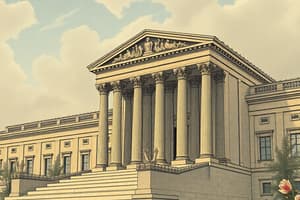Podcast
Questions and Answers
What is the primary function of the judicial branch as established in the US Constitution?
What is the primary function of the judicial branch as established in the US Constitution?
- To interpret laws and settle disputes. (correct)
- To negotiate treaties with foreign nations.
- To enforce laws passed by the legislative branch.
- To create and enact laws for the nation.
Why did the framers of the U.S. Constitution strategically distribute power among different branches of government?
Why did the framers of the U.S. Constitution strategically distribute power among different branches of government?
- To limit the scope of judicial review.
- To prevent any single branch from becoming too powerful. (correct)
- To expedite the law-making process.
- To ensure the dominance of the executive branch.
Alexander Hamilton referred to the judiciary as the 'least dangerous' branch because he believed it:
Alexander Hamilton referred to the judiciary as the 'least dangerous' branch because he believed it:
- Was directly elected by the people.
- Had the power to declare laws unconstitutional.
- Could easily be influenced by public opinion.
- Lacked the power of enforcement and relied on the other branches. (correct)
How does the selection process of federal judges and Supreme Court justices reflect political influences?
How does the selection process of federal judges and Supreme Court justices reflect political influences?
In the context of the American legal system, what does the 'federal court system' encompass?
In the context of the American legal system, what does the 'federal court system' encompass?
What role does the Senate play in the appointment of federal judges and justices to the Supreme Court?
What role does the Senate play in the appointment of federal judges and justices to the Supreme Court?
Why did the framers of the Constitution grant federal judges lifetime appointments?
Why did the framers of the Constitution grant federal judges lifetime appointments?
According to Article III of the Constitution, what authority does Congress have over the federal court system?
According to Article III of the Constitution, what authority does Congress have over the federal court system?
What fundamental principle regarding federal crimes is outlined in the Constitution?
What fundamental principle regarding federal crimes is outlined in the Constitution?
What is the significance of the Judiciary Act of 1789 in the context of the U.S. legal system?
What is the significance of the Judiciary Act of 1789 in the context of the U.S. legal system?
Which of the following is an example of how Congress can check the power of the judicial branch?
Which of the following is an example of how Congress can check the power of the judicial branch?
What does Article III, Section 3 of the Constitution define, and what requirement does it set?
What does Article III, Section 3 of the Constitution define, and what requirement does it set?
How did the creation of the federal judicial branch impact the resolution of disputes in America?
How did the creation of the federal judicial branch impact the resolution of disputes in America?
Which statement describes the creation of federal courts after the ratification of the Constitution?
Which statement describes the creation of federal courts after the ratification of the Constitution?
How do interest groups influence the cases heard by the Supreme Court?
How do interest groups influence the cases heard by the Supreme Court?
According to the information, what does the American legal system include?
According to the information, what does the American legal system include?
Which branch of the U.S. government is responsible for nominating judges to the federal courts and justices to the Supreme Court?
Which branch of the U.S. government is responsible for nominating judges to the federal courts and justices to the Supreme Court?
Which of the following is an example of extra-legal factors that impact judicial decision making?
Which of the following is an example of extra-legal factors that impact judicial decision making?
What does it mean that judges 'hold their office during good behavior?'
What does it mean that judges 'hold their office during good behavior?'
What is the primary responsibility of the judicial branch as defined in Article 3 of the US Constitution?
What is the primary responsibility of the judicial branch as defined in Article 3 of the US Constitution?
Article III of the U.S. Constitution details the powers and provisions of the Executive Branch.
Article III of the U.S. Constitution details the powers and provisions of the Executive Branch.
The judicial branch was explicitly defined and functioning under the Articles of Confederation before the U.S. Constitution was established.
The judicial branch was explicitly defined and functioning under the Articles of Confederation before the U.S. Constitution was established.
The framers of the U.S. Constitution centralized all governmental power within the presidential office to ensure decisive national leadership.
The framers of the U.S. Constitution centralized all governmental power within the presidential office to ensure decisive national leadership.
The role of the courts is perceived today similarly to its original design when the national government was formed in 1788.
The role of the courts is perceived today similarly to its original design when the national government was formed in 1788.
The Framers unanimously agreed on establishing lower federal courts beneath the Supreme Court.
The Framers unanimously agreed on establishing lower federal courts beneath the Supreme Court.
Article 3, Section 1, definitively outlines the number of inferior courts Congress must establish.
Article 3, Section 1, definitively outlines the number of inferior courts Congress must establish.
The Judiciary Act of 1789 limited the Supreme Court's power, ensuring the states had ultimate legal authority.
The Judiciary Act of 1789 limited the Supreme Court's power, ensuring the states had ultimate legal authority.
Judicial review is explicitly described as a power of the judiciary in the Constitution.
Judicial review is explicitly described as a power of the judiciary in the Constitution.
The creation of the federal judicial branch resulted in minimal changes to the resolution of legal disputes in America.
The creation of the federal judicial branch resulted in minimal changes to the resolution of legal disputes in America.
The selection process for federal judges is carefully designed to be apolitical.
The selection process for federal judges is carefully designed to be apolitical.
The Supreme Court hears all of the cases filed in courts across the United States.
The Supreme Court hears all of the cases filed in courts across the United States.
The President of the United States has sole power to appoint all federal judges.
The President of the United States has sole power to appoint all federal judges.
Flashcards
Article 3 of the Constitution
Article 3 of the Constitution
Article 3 of the US Constitution outlines the provisions and powers of the judicial branch.
Role of the Judicial Branch
Role of the Judicial Branch
The judicial branch was created to interpret laws and settle disputes ensuring fair application and resolution.
Judiciary Under the Articles of Confederation
Judiciary Under the Articles of Confederation
Before the Constitution, there was no independent judicial branch under the Articles of Confederation.
Why Create a Judiciary?
Why Create a Judiciary?
Signup and view all the flashcards
"Least Dangerous Branch"
"Least Dangerous Branch"
Signup and view all the flashcards
Judicial Branch Power
Judicial Branch Power
Signup and view all the flashcards
Perception of Judicial Power
Perception of Judicial Power
Signup and view all the flashcards
Federal Court System
Federal Court System
Signup and view all the flashcards
Selecting Federal Judges
Selecting Federal Judges
Signup and view all the flashcards
Judicial Decision-Making
Judicial Decision-Making
Signup and view all the flashcards
Framers' View of Federal Judiciary
Framers' View of Federal Judiciary
Signup and view all the flashcards
Early Debate on Federal Courts
Early Debate on Federal Courts
Signup and view all the flashcards
Article III, Section 1
Article III, Section 1
Signup and view all the flashcards
Judiciary Act of 1789
Judiciary Act of 1789
Signup and view all the flashcards
Judicial Review
Judicial Review
Signup and view all the flashcards
Section 1 of Article 3
Section 1 of Article 3
Signup and view all the flashcards
Section 2 of Article 3
Section 2 of Article 3
Signup and view all the flashcards
Section 3 of Article 3
Section 3 of Article 3
Signup and view all the flashcards
Life Tenure of Judges
Life Tenure of Judges
Signup and view all the flashcards
Checks on Judicial Power
Checks on Judicial Power
Signup and view all the flashcards
Article 3 Purpose
Article 3 Purpose
Signup and view all the flashcards
Judicial Branch Origins
Judicial Branch Origins
Signup and view all the flashcards
Separation of Governmental Power
Separation of Governmental Power
Signup and view all the flashcards
Supreme Court Access
Supreme Court Access
Signup and view all the flashcards
Judicial Review Definition
Judicial Review Definition
Signup and view all the flashcards
Federal Judge Appointment
Federal Judge Appointment
Signup and view all the flashcards
Judiciary Act Details
Judiciary Act Details
Signup and view all the flashcards
Study Notes
- Article 3 of the US Constitution outlines the provisions and powers of the judicial branch, which balances the other two branches of government.
- The judicial branch is tasked with interpreting and enforcing laws.
- The federal judicial branch has established the American court system as a foundation for settling disputes.
- Before the creation of the judicial branch under the Articles of Confederation, no judicial branch of government existed.
- The absence of a judicial branch under the Articles of Confederation, served as a motivation to create a new Constitution.
- Most of the power rested with Congress, who held the authority to make decisions for the nation.
- The framers of the US Constitution instilled the power of interpreting and making decision based on the law within the judicial branch of government
- The framers strategically distributed power, avoiding concentrating it in either the presidential or congressional branches.
"Least Dangerous" Branch
- In 1787, Alexander Hamilton believed the judiciary would be the weakest of the three departments of government, calling it the "least dangerous" branch.
- Initially, the national government even forgot to include space for the justices of the Supreme Court when moving to the District of Columbia.
- Today, the role of the courts, especially the Supreme Court, differs significantly from the vision in 1788, the year the national government was established.
- Elected presidents nominate judges to federal courts and justices to the Supreme Court, which often advances their personal politics.
- The selection process, and the process by which cases are heard by the Supreme Court, is often political.
- Interest groups seek out test cases to advance policy positions, while the Department of Justice aims to advance its version of the public interest in court.
Scope and Development of Judicial Power
- The Constitution and the creation of the federal judiciary, the American legal system, and the federal court system.
- Constitution and the creation of the federal judiciary, including the Judiciary Act of 1789 and the establishment of the federal judicial system.
- Article III of the Constitution established the Supreme Court, but Congress was tasked with creating other federal courts.
- The American legal system encompasses the concepts of civil and criminal law.
- The federal court system comprises specialized courts, district courts, courts of appeals, and the Supreme Court, which is the ultimate authority on all federal law.
- All appointments to the federal district courts, courts of appeals, and the Supreme Court are made by the president and are subject to Senate confirmation.
- Only a small fraction of the millions of cases filed yearly in courts across the United States eventually reach the Supreme Court through the appellate process.
- Judicial philosophy and decision-making involve judicial decision-making relies on a range of legal and extra-legal factors.
- Framers believed that a federal judiciary posed little of the threat of tyranny that they feared from the other two branches.
- James Madison made apparent at the Constitutional Convention in Philadelphia that Article III, which created the judicial branch of government, was written and given little thought by the Framers.
- There was an argument about the ratification process of the constitution.
- Alexander Hamilton insisted that it was the least dangerous, but Anti-Federalists disagreed.
- Anti-Federalists feared that the ability to interpret "the supreme law of the land" would grant the Supreme Court too much power.
- The Framers also debated the need for federal courts below the Supreme Court level.
- Some advocated for deciding all cases in state courts, with only appeals going to the Supreme Court, while others argued for a system of federal courts.
Constitution
- Article III, section 1, vests "The judicial Power of the United States... in one supreme Court, and in such inferior Courts as the Congress may from time to time ordain and establish."
- A compromise was reached between the two sides that left the final choice to Congress.
Judiciary act of 1789
- The Judiciary Act of 1789 is the federal act that established the lower federal courts and defined other functions of the federal judiciary.
- This act included specifying the jurisdiction and powers of the district and circuit courts, alongside regulating the qualifications and authority of federal judges, district attorneys, court clerks, U.S. Marshals, and Deputy Marshals.
Judicial Review
- The power of the courts to review acts of other branches of government and states.
- Judicial review is not explicitly stated in the Constitution.
- Judicial review was resolved in the Marbury v. Madison (1803) case.
- Section 1 of the Constitution granted Congress the authority to establish other courts.
- Section 2 specifies the judicial power of the Supreme Court, including the Court's original and appellate jurisdiction.
- All federal crimes, excluding those involving impeachment, shall be tried by jury in the state where the crime was committed.
- Section 3 defines treason and mandates that at least two witnesses appear in such cases.
- Although the Chief Justice presides over presidential impeachments, it is not mentioned in Article III.
- Article I, section 3, addresses the “When the President of the United States is tried, the Chief Justice shall preside.”
Life Tenure of the Judges
- Article III states that these judges "hold their office during good behavior,” meaning they have a lifetime appointment, except under very limited circumstances.
- Framers did not want the justices (or any federal judges) subject to the whims of politics, the public, or politicians.
Checks on the Power of the Judiciary
- The Constitution gives Congress the authority to alter the Court's jurisdiction.
- Congress can propose constitutional amendments to reverse judicial decisions and can impeach/remove federal judges.
- The president, with the Senate's advice, appoints all federal judges.
Studying That Suits You
Use AI to generate personalized quizzes and flashcards to suit your learning preferences.





